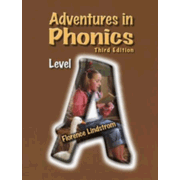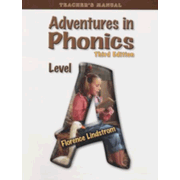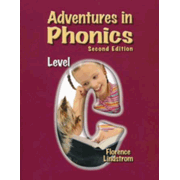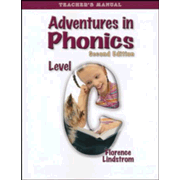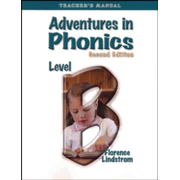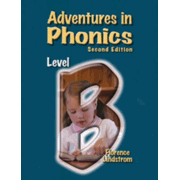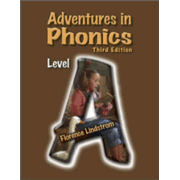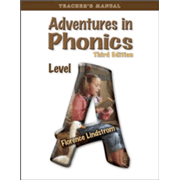Adventures in Phonics teaches phonics in a traditional manner with phonograms and rules. It begins in Level A with single-letter phonograms, teaching both upper- and lower-case letters simultaneously. While it might be used as your first phonics program, children should already have some familiarity with letters and sounds before beginning Level A since the pace of the course is fairly intensive. Adventures in Phonics can be used for core phonics instruction or as a supplement alongside other methods. It is similar in concept to the Modern Curriculum Press “Plaid” Phonics series, but it is definitely more challenging. Christian Liberty Press (CLP) incorporates Levels A, B, and C into their kindergarten, first, and second grade programs respectively. Some children will not be ready to complete Level A before first grade.
Student workbooks are printed in two colors (i.e., black and shades of either blue or brown on white pages) and use clip-art and line-drawn illustrations. Workbooks include space for children to write, but lines are relatively small for the suggested grade levels—1/2 inch in height for Level A, 5/16 in Level B, and a mixture of 5/16 and 7/16 in Level C. Pages in Levels B and C look a little crowded and busy. Workbook pages are mostly typical fill-in-the-blank or circle-the-correct-answer exercises. While the visual look of the workbook pages isn't impressive, appearance isn't likely to be a big issue one way or the other. But the size of the lines might be an important consideration.
The teacher's manuals have overprinted answers on reduced images of student pages as well as brief, easy-to-follow lesson plans. Preparation for each lesson is minimal (e.g., having particular flashcards on hand).
Christian content shows up both in the vocabulary and, occasionally, in sentences in the exercises.
Level A presents basic phonics covering most of the phonograms for both short and long vowel pronunciations as well as many vowel and consonant digraphs. Vowel sounds are taught in “sound families” (e.g., all the ways of making the /ō/ sound). Children also learn manuscript printing. By the end of Level A, students are reading and writing words like "bridge, daughter, giraffe," and "pledge."
If you want to use this as your core program, lessons need to be taught using the information in the teacher's manual and a companion set of phonics flashcards and charts (also published by CLP). Level A's manual shows how to correlate the flash cards.
Through much of Level A, students are given models of letters, words, and sentences to trace and copy—they trace letters and words through the first third of the book, then begin copying. Periodic reviews challenge students to write words without models to trace or copy. Most children will need additional handwriting and reading practice beyond what is required in these lessons. On page 38 of the teacher's manual, the student is encouraged to start reading the first book in the Christian Liberty Phonics Reader series. Reading subsequent readers in the series is indicated at appropriate intervals.
Little attention is given to teaching how to blend the sounds together for words. Instead, children practice writing and saying words. This might be sufficient for some children, but others might need more practice on blending.
Level B reviews previously taught information then continues with more challenging phonics, syllabication, accented syllables, prefixes, suffixes, apostrophes, synonyms, antonyms, homonyms, and alphabetizing. Level C covers essentially the same topics, advancing the level of difficulty with more challenging vocabulary, additional rules, smaller fonts, and more activities to complete per page. Phonics rules are presented in charts at the end of student workbooks for both Levels B and C.
Instructions are at the top of student workbook pages for Levels B and C, and you might find that you rarely use the teacher's manuals. For both Levels B and C you will almost certainly want to use supplemental readers whether from CLP or another source. By the end of Level C, students should be able to read words such as "stretch, psalm, rhubarb, rhythm, pheasant, photograph," and "orchestra."
The Adventures in Phonics series offers a very inexpensive option whether it's used for core phonics instruction or supplemental work. While it's not as visually impressive as some other programs, it is very easy for parents to use and it does a solid job of teaching phonics.











